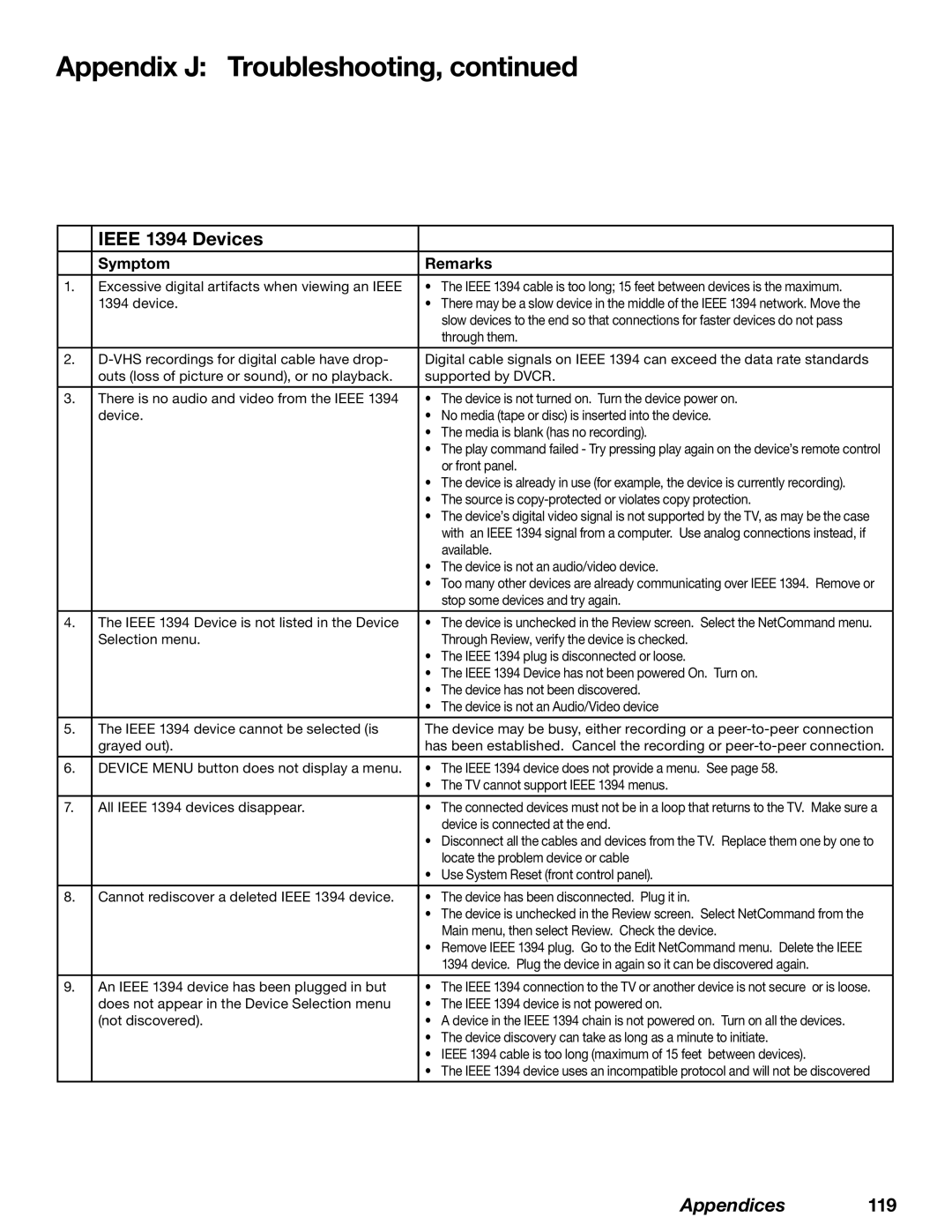Appendix J: Troubleshooting, continued
| IEEE 1394 Devices |
|
| Symptom | Remarks |
|
|
|
1. | Excessive digital artifacts when viewing an IEEE | • The IEEE 1394 cable is too long; 15 feet between devices is the maximum. |
| 1394 device. | • There may be a slow device in the middle of the IEEE 1394 network. Move the |
|
| slow devices to the end so that connections for faster devices do not pass |
|
| through them. |
|
|
|
2. | Digital cable signals on IEEE 1394 can exceed the data rate standards | |
| outs (loss of picture or sound), or no playback. | supported by DVCR. |
|
|
|
3. | There is no audio and video from the IEEE 1394 | • The device is not turned on. Turn the device power on. |
| device. | • No media (tape or disc) is inserted into the device. |
|
| • The media is blank (has no recording). |
|
| • The play command failed - Try pressing play again on the device’s remote control |
|
| or front panel. |
|
| • The device is already in use (for example, the device is currently recording). |
|
| • The source is |
|
| • The device’s digital video signal is not supported by the TV, as may be the case |
|
| with an IEEE 1394 signal from a computer. Use analog connections instead, if |
|
| available. |
|
| • The device is not an audio/video device. |
|
| • Too many other devices are already communicating over IEEE 1394. Remove or |
|
| stop some devices and try again. |
|
|
|
4. | The IEEE 1394 Device is not listed in the Device | • The device is unchecked in the Review screen. Select the NetCommand menu. |
| Selection menu. | Through Review, verify the device is checked. |
|
| • The IEEE 1394 plug is disconnected or loose. |
|
| • The IEEE 1394 Device has not been powered On. Turn on. |
|
| • The device has not been discovered. |
|
| • The device is not an Audio/Video device |
|
|
|
5. | The IEEE 1394 device cannot be selected (is | The device may be busy, either recording or a |
| grayed out). | has been established. Cancel the recording or |
|
|
|
6. | DEVICE MENU button does not display a menu. | • The IEEE 1394 device does not provide a menu. See page 58. |
|
| • The TV cannot support IEEE 1394 menus. |
|
|
|
7. | All IEEE 1394 devices disappear. | • The connected devices must not be in a loop that returns to the TV. Make sure a |
|
| device is connected at the end. |
|
| • Disconnect all the cables and devices from the TV. Replace them one by one to |
|
| locate the problem device or cable |
|
| • Use System Reset (front control panel). |
|
|
|
8. | Cannot rediscover a deleted IEEE 1394 device. | • The device has been disconnected. Plug it in. |
|
| • The device is unchecked in the Review screen. Select NetCommand from the |
|
| Main menu, then select Review. Check the device. |
|
| • Remove IEEE 1394 plug. Go to the Edit NetCommand menu. Delete the IEEE |
|
| 1394 device. Plug the device in again so it can be discovered again. |
|
|
|
9. | An IEEE 1394 device has been plugged in but | • The IEEE 1394 connection to the TV or another device is not secure or is loose. |
| does not appear in the Device Selection menu | • The IEEE 1394 device is not powered on. |
| (not discovered). | • A device in the IEEE 1394 chain is not powered on. Turn on all the devices. |
|
| • The device discovery can take as long as a minute to initiate. |
|
| • IEEE 1394 cable is too long (maximum of 15 feet between devices). |
|
| • The IEEE 1394 device uses an incompatible protocol and will not be discovered |
|
|
|
Appendices 119
